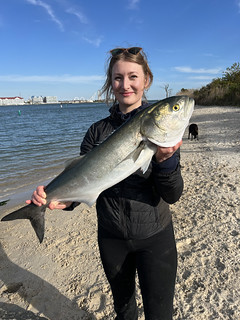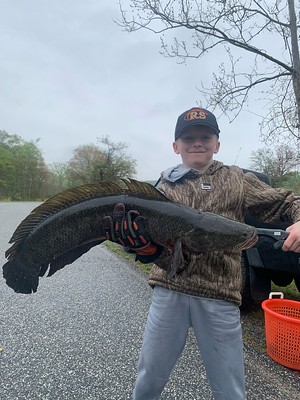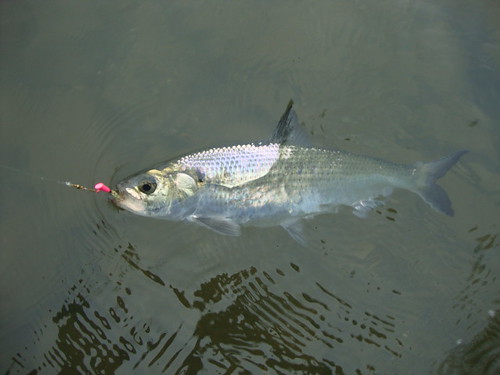
Ivanna Harshman holds up a large bluefish caught near Ocean City. Photo by Mary Harshman
As we celebrate the beginning of May, balmy weather makes for comfortable fishing from the mountains of western Maryland to the shores of the Atlantic Ocean. Summer migrant species are showing up in the Ocean City area; among the arrivals is the spring migration of bluefish.
Forecast Summary: May 1 – May 7:
Unstable but warm weather this week will make for generally good fishing conditions in Maryland’s waters. Chesapeake Bay surface water temperatures have jumped nearly 8 degrees since last week to the high 60s. River temperatures have also risen to the middle 60s, although smaller streams and downwind areas will warm faster on a sunny day and can hold temperatures even warmer. With Maryland’s part of the Bay running fresher than average, there will be abundant areas with suitable salinity for hunting blue catfish. Look for hickory and American shad in low salinity areas as they move upriver to spawn. Keep an eye out for large game fish ambushing the shad as they move upriver.
Expect average flows for most of Maryland rivers and streams. Expect poor but improving water clarity for the Maryland portion of the Bay from the Sassafras River down to the Bay Bridge, and the Potomac River from Mattawoman Creek down to the 301 Bridge. To see the latest water clarity conditions, check Eyes on the Bay Satellite Maps. There will be above average tidal currents Saturday through Tuesday as a result of the new moon on May 8.
For more detailed and up-to-date fishing conditions in your area, continue to check out Click Before You Cast.
Upper Chesapeake Bay

Angler Bryson Youngblood with a northern snakehead, photo by Bret DeMond
At the top of the Bay, anglers are still catching and releasing a mix of hickory and American shad, although reports say catches of hickory shad are beginning to decline. Flathead catfish are being caught in the Conowingo Dam pool and the adjacent river waters. White perch are being caught in the Susquehanna River this week and many anglers are putting together nice catches using small jigs and shad darts tipped with grass shrimp or pieces of bloodworm and artificial bloodworm baits.
Catches of large blue catfish are dominating the fishing scene in the upper Bay from the mouth of the Susquehanna south to the Bay Bridge. The size of the catfish tends to be astounding, most weighing between 15 and 40 pounds. Water temperatures are warm enough that they are spread out across wide areas of the Bay. Channel edges and most areas in the upper Bay and the tidal rivers are fair game when looking for blue catfish. The fishing piers, accessible waterfronts, and Sandy Point State Park are all good places to fish for them. It has not rained in a while and salinities are starting to elevate from a couple of weeks ago; another rain event will most likely lower the salinities again.
A variety of baits will work when fishing for blue catfish; cut bait of menhaden or gizzard shad is at the top of the list. Other popular baits include cut white perch, scented chicken breast, and chicken liver. Circle hooks on a fish-finder rig is the most popular rig and a 2-inch float helps keep the bait slightly off the bottom.
Northern snakeheads are providing good fishing in the middle and upper sections of the region’s tidal rivers and creeks. Water temperatures are warming enough that snakeheads are becoming more active, especially the larger ones. The most popular ways to fish for them are casting white paddletails and chatterbaits with large soft plastic trailers and fishing large minnows under a bobber.
White perch are being caught in many of the tidal rivers, in their middle and upper sections. Most anglers are enjoying good fishing by casting small spinnerbaits and roadrunner type lures. Others are enjoying good fishing by using grass shrimp on a small shad dart or jig head or under a bobber or bottom rig. Pieces of bloodworm will work well also.
Middle Bay
If anglers are looking for plenty of pull this week, large blue catfish are ready and willing to give you a hefty tug. Large – and we do mean large – blue catfish can be found from the Bay Bridge south to at least Chesapeake Beach. Low salinities have proved comfortable for these large catfish to roam the middle Bay, in areas along channel edges and places like Hacketts Bar, the Brickhouse Bar, Eastern Bay, behind Tilghman Island, and the mouths of the Choptank River and other tidal rivers.
Anglers itching to get their boats out on the water are enjoying fishing with family and friends in a variety of locations. The set up is rather simple – just anchor up and let out some baits of cut menhaden, gizzard shad, or chicken liver or scented chicken breast meat. Circle hooks on a sliding egg sinker or fish-finder rig is the most popular way to fish. The classic tactic is to set up and if no bites happen in 20 minutes, try another location.
Anglers fishing from shore can fish at the Matapeake Fishing Pier or private docks and shorelines along the Bay with excellent chances of catching large blue catfish. Water temperatures in the middle Bay are around about 60 degrees this week and salinities are up to about 7 ppt due to the lack of rain. It will be interesting to see how long the blue catfish tolerate higher salinities.
White perch are providing plenty of fun fishing for anglers in the region’s tidal rivers and creeks this week. Many anglers are casting small spinnerbaits and spinner jigs with very good results for a nice grade of white perch. In deeper waters anglers are fishing with bottom rigs baited with grass shrimp or pieces of bloodworm.
Lower Bay

Hickory shad, photo by Ken Kopro
Anglers are seeing the hickory shad and American shad spawning runs in the District of Columbia section of the tidal Potomac River, providing good catch-and-release fishing, but the peak of the hickory shad run is beginning to diminish. American shad continue to be found in good numbers. High flows and cloudy water conditions in the river have not helped the situation. Tandem rigs of shad darts and small flashy gold and silver spoons are the most popular rigs being used.
There is certainly no shortage of blue catfish in the tidal Potomac and anglers are catching them from the Wilson Bridge all the way to the mouth of the river near Solomons. The blue catfish are on the move due to warmer water temperatures and are not just found in the deeper channels any longer, as channel edges are offering good places to fish. Anglers are setting up in a variety of locations and if they don’t have action in the first 20 minutes just move to another site. The Patuxent and Nanticoke rivers also have large populations of blue catfish.
Fresh cut baits of gizzard shad, menhaden, chicken liver of chicken breast scented with various scents. Circle hooks are the most popular hook to use, often with a 2-inch float to keep baits off the bottom. A sliding egg sinker or fish-finder rig allows the catfish to move off with the bait and engage the circle hook in the corner of the catfish’s mouth. Bait runner spinning reels and conventional reels in free spool help lessen resistance when a catfish is moving off with a bait.
Anglers are finding a few black drum in the Pocomoke Sound, Middle Grounds, and Target Ship area. These are the vanguard of the spring black drum run, so success can be a hit and miss. Finding the fish on a depth finder and dropping baits of clams or soft crab can lead to some exciting action. Cownose rays are also arriving in the lower Bay region and are living up to their reputation as being pesky bait stealers if you are fishing for black drum or blue catfish.
White perch are providing good fishing in the tidal rivers and creeks of the lower bay region this week. In the shallower waters less than 15 feet deep, anglers are enjoying fun light-tackle fishing by casting small spinnerbaits or spin jigs. Others are fishing grass shrimp under slip bobbers with good success or using grass shrimp or pieces of bloodworm on a bottom rig. The white perch are steadily moving to their summer habitats in the lower sections of the tidal rivers.
Freshwater Fishing

Justin Rutledge caught and released this beautiful smallmouth bass in Liberty Reservoir. Photo courtesy of Justin Rutledge
Trout anglers are enjoying continued stockings in the put-and-take as well as delayed harvest waters this week. Water temperatures are still acceptable for trout survival in the central and southern regions. These trout management waters will continue to receive stockings if water temperatures support survival of the fish. The western region’s streams and reservoirs usually do much better in maintaining water temperatures that allow trout to survive the summer months.
As the warmer weather prevails, it opens a wonderful opportunity for fly fishing in the catch-and-release trout management waters. Presentations of various nymphs, streamers, and dry flies match hatches of stream invertebrates as well as terrestrials. Other trout management waters allow anglers to use spinning gear and artificial lures. The Maryland Department of Natural Resources website provides explanations of the various trout management areas.
Warmer weather has been very inviting to anglers to enjoy a variety of freshwater fishing opportunities this week. Largemouth bass are in a pre-spawn mode of behavior in the western and parts of the central regions and are actively spawning in warmer waters of the central, southern, and eastern regions. The male largemouth bass can be found on the spawning beds in most areas and the female largemouth bass are either holding outside those spawning bed areas or actively spawning.
Crappie are spawning in the deeper waters of ponds, reservoirs, and tidal water across Maryland this week. Various species of sunfish are also actively spawning at this time and their nests can be seen carved out along sandy shallows. Chain pickerel continue to provide good fishing opportunities in both non-tidal and tidal waters. Other species including smallmouth bass are providing excellent fishing in the upper Potomac, the lower Susquehanna River, and Prettyboy and Liberty reservoirs.
Warmer water temperatures are causing northern snakeheads to become very active and they are aggressively feeding, building up body stores for the upcoming spawning season. A variety of lures will entice snakeheads to strike – white paddletails, chatterbaits rigged with white soft plastic creature baits, frogs, and buzzbaits are all good choices. Grass beds are growing and are a good place to target, while sunken shoreline wood and brush also are good places to look for northern snakeheads.
Atlantic Ocean and Coastal Bays

David Weller holds up a nice flounder that he caught recently at Ocean City. Photo by David Weller
Anglers along the beaches of Assateague Island are enjoying a mixed bag in the surf in the form of black drum, large bluefish, and striped bass. The coastal migration of large striped bass has yet to arrive off the local beaches but should occur in another week or so. The large spring migrant bluefish are often called “runners” due to their being thin from a long travel route and failure to build up body stores.
At the Ocean City Inlet and the Route 50 area tautog are a major focus for anglers using sand fleas and pieces of crab for bait. The areas around the jetty rocks, bulkheads and bridge piers are holding some of the greatest numbers of tautog. There is a good mix of tautog measuring 16 inches or larger along with sub-legal tautog. Striped bass and large bluefish are being caught by anglers casting soft plastic jigs and paddletails.
Flounder are beginning to show up in greater numbers and provide a chance for anglers to enjoy some flounder fishing. The channel areas leading from the inlet offer the best fishing opportunities.
Fishing for tautog at the offshore wreck and reef sites continues to be very good this week, with limit catches being common and tautog weighing in the double-digit range being caught and released. The 2024 tautog season will close May 16 and will reopen July 1 through October 31 with a two-fish daily limit. The 2024 black sea bass season opens May 15 to September 30 with a limit of 15 fish per day at a minimum size of 13 inches.
“There is nothing that attracts human nature more powerfully than the sport of tempting the unknown with a fishing line.” – Henry Van Dyke
Maryland Fishing Report is written and compiled by Keith Lockwood, fisheries biologist with the Maryland Department of Natural Resources.
Click Before You Cast is written by Tidewater Ecosystem Assessment Director Tom Parham.
This report is now available on your Amazon Echo device — just ask Alexa to “open Maryland Fishing Report.”
